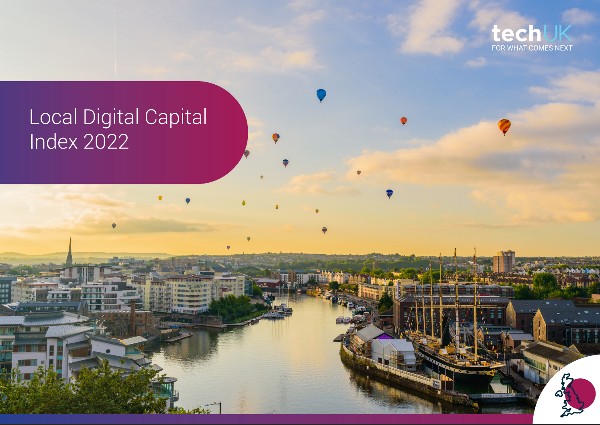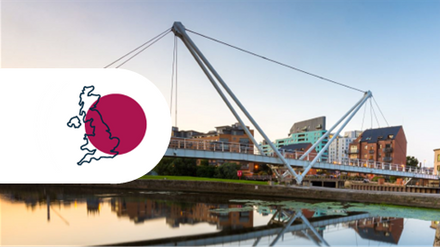Local Digital Capital Index 2022
The Local Digital Capital Index is a guide that describes the impact and value technology can bring to a region, showcasing its strengths and providing direction for development. It can be used by policy makers to address the challenges faced by each nation and region in the UK more confidently using data that shows where investment should be directed. The Index helps build a strong tech ecosystem between sectors, policy makers, companies and government by providing data that encourages collaboration between regions.

The Index is aimed at supporting local tech ecosystems across the UK and encouraging investment, collaboration and further activity in those areas. That’s not because the tech sector as it stands isn’t contributing to the economy. It is. It’s because we know that for the tech sector in the UK to achieve its true potential, and for the UK economy to achieve its true potential, it will require a strong, skilled, connected and well-distributed tech sector. techUK launched the Local Digital Capital (LDC) Index in 2021 having spoken to over 260 public sector, civic, academic and business leaders as part of the Building the Future We Need campaign.
The challenge going forward for the Government and the sector is ensuring that no area of the UK is without the capacity and capability to allow businesses, citizens, public services, third sector parties and others to be included in the advancement of digital technology and the benefits that it brings.
The LDC Index and subsequent recommendations show this is possible, and by engaging and unleashing the talent, energy and innovation of the sector we can move from the prospect of being possible to one where it is probable.
Skills
Digital Adoption
Digital Infrastructure
Research & Development
Finance & Investment
Trade
How to use
The map on the left shows how each area ranks in this year's Local Digital Capital Index, with higher ranking areas appearing darker on the map. You can zoom in and out using your scroll wheel. If you get lost, press 'Reset Zoom' to go back to the original view. Hovering over an area will display more detail about in this panel.
Pressing on one of the buttons above will filter the data to show you how each area ranks in each of the constituent metrics that make up the Local Digital Capital Index: Skills; Digital Adoption; Infrastructure; Finance and Investment; Research and Development; and Trade. More detail on the methodology can be found below.
The table below shows the full data from the 2022 Local Digital Capital Index for each of the NUTS2 areas. You can sort on each of the metrics using the arrows in the table header.
Local Digital Capital 2022 - Index Data and methodology
Thanks must be extended to Henham Strategy for their time, work and commitment in helping develop the Local Digital Capital Index for 2022. You can download the LDC index methodological note and LDC Index Data here.
Local Digital Capital 2022 - snapshot of Nations and Regions
East England |
The East of England ranks 3rd at NUTS1 level and at ‘sub-region’ level – Bedfordshire & Hertfordshire, Essex and East Anglia – all the regions perform relatively well. Digital Infrastructure should be improved in East Anglia but Finance and R&D both score in the top 10. Digital skills in Essex (12th) is a success and further exploration on this would be worth exploring.
|
|---|---|
East Midlands |
Perhaps surprisingly Derbyshire and Nottinghamshire score well, powered by decent mobile coverage, good numbers in digital occupations and inward investment in ICT. But it’s a 6th place score in R&D that really means this patch scores well. However the region suffers the same rural/urban split as other areas and Lincolnshire’s challenges draw the wider East Midlands to 8th overall (up on 10th in 2021). |
Greater London |
It will come as little shock that London is at the apex of the regional list, but also snaps up 3 of the top 4 spots when considering the new smaller regional statistics. Strengths are visible across almost all the competencies. However Outer East & NE and South London score poorly on R&D and trade. Perhaps this is offset by the close proximity to high performing neighbours? |
North East |
The wider North East’s scores appear to be high (digital infrastructure) or low (skills or finance & investment). However some of this needs considering against their peers e.g. on R&D Tees Valley and Durham score well and both NE regions receive more Innovate UK grants than West Yorkshire. However the service sector exports aren’t as good when comparing the same regions and they have less high growth businesses. |
North West |
The North West was 7th in 2021 and retains that position in 2022. However, the updated data this year shows an intraregional divide. Greater Manchester and Merseyside have strong digital infrastructure scores but fall back on other components. Digital skills and developing R&D further form two obvious areas of future focus. There is a rural/urban spilt in the region with Cumbria seeing particularly low scores in infrastructure, skills and adoption. Greater Manchester’s 540 high growth businesses (HGB’s) and 130k digital occupations is a significant achievement and with a further 210 HGB’s on Merseyside and over 60k digital occupations this adds to the regions digital growth potential. |
Northern Ireland |
Northern Ireland’s scoring remains in the lower half of the table. However, this figure may not recognise the nuances such as the strength of home grown firms like Kainos or the strength of the cyber security in the region. With over 65k Higher Education students, over 74k digital occupations and 285 high growth businesses, there is further potential for tech growth. |
Scotland |
Scotland demonstrates a mixed picture in terms of the overall strength of the tech sector. While some localities show very positive results that indicate Scotland’s tech sector is as competitive as anywhere else in the UK, there is also a lag for many rural areas. Skills are a strength in Eastern and North Easter Scotland, and with Eastern Scotland (the region including Edinburgh) finishes 11th overall. With over 189k higher education students – more than the West Midlands, there is further skills potential. Digital infrastructure is an area for improvement in ensuring digital reaches beyond the urban areas/cities of Scotland. |
South East |
The South East ranks second and all the ‘sub regions’ relatively score well overall. The strong performance by Berkshire, Buckinghamshire & Oxfordshire – 1st in digital adoption and in R&D is notable. Similarly Surrey, East and West Sussex and Hampshire & the Isle of Wight score well (with 7 top 10 spots across the different components collectively). Digital infrastructure is the area for potential improvement with no sub-region entering the top 10 despite strong scoring in other measures. |
South West |
The strong regional performance is totally driven by Gloucestershire, Wiltshire, Bath & Bristol. The other areas all fall into the bottom third and clearly there is a challenge for these rural and coastal communities. Digital infrastructure is a clear element for improvement across the whole SW but many other measures require attention and action. |
Wales |
Wales’ scoring masks areas of good practice and that Wales’ skills score is high shows the potential for growth. Improving digital infrastructure is important to change that perception but the Digital Strategy for Wales sets out some of the work underway and planned. |
West Midlands |
Overall the region does well when considered as a whole and within the region there are strengths to note such as digital infrastructure strengths as well as significant R&D strengths. With over 108k digital occupations in the WM sub-region and 385 high growth businesses this compares well against their peers. Furthermore the HE students in the West Midlands (187,100) is more than the North West (175,300) and significantly more than Y&H (139,155) and the North East (71,680). |
Yorkshire and Humber |
Yorkshire and Humber offers another mixed picture of intra-region variation. Infrastructure scoring is better in the more ‘urban’ areas however these areas don’t score as well as North Yorkshire for finance and investment. Middle to low scoring in skills and adoption add to the regions mixed picture. |
Recommendations
techUK’s Local Digital Capital Index helps us see the reality and challenge facing the UK. These are steps that should be taken by the Government to seek to empower local leaders, work with business and encourage more data to be shared and available to inform decision making (and track progress).
-
Ensure that Project Gigabit reaches all areas of the UK, particularly rural communities and more national comparable data on 5G coverage. Digital infrastructure underpins much of the scoring – it’s hard to feature higher up the Index without it. Better data, an increased focus on rural reach and pursue 5G where innovation can be bolstered and furthered using this technology.
-
Investment Zones have been announced by the Government and are seeking expressions of interest. This provides an opportunity for clearly defined areas to be used to roll out and prepare for the further role of new technologies such as autonomous vehicles (AV). These new investment zones allow digital infrastructure to be in place immediately with built in capacity for the future, to provide capacity for dedicated AV lanes encourage the adoption of new technologies and help speed up readiness for AV regulations in 2025. Investment zones must also be ‘tech zones’ to attract people to work in them, base their business in them and secure new future investment.
-
Improved skills data is essential to ensure that activity and comparisons are consistent across the UK. techUK would want to go further looking at education data, subject choices, progress, demographic data, job seeker training, and skills/training for those in work. Further analysis on the most tech skilled would also be useful in looking at the ‘most talented’ but also improving the wider populations confidence in their own digital skills.
-
Digital action and activity to be identified in future Levelling Up bids and projects to help address regional divides and exclusion. This doesn’t need to necessarily be funding toward digital projects directly but actually how improving a town centre can improve digital skills or what else could be done to improve digital infrastructure on the back of this e.g. free Wi-Fi in town centres.
-
More data shared more regularly on initiatives such as Help to Grow Digital, to allow local activity to support national schemes. Central Government schemes are great but they need local activity to sustain and complement them. LEPs, Chamber of Commerce, CBI, techUK etc., can all look to signpost to further support or encourage uptake in regions where it is low.
-
The data needed to measure data ecosystems across the UK still isn’t conclusive or consistent and needs to be addressed. Government should look to running a testbed with a Combined Authority to build a working model that can be adopted elsewhere.
-
Devolved Government and elected Mayors need to publish and regularly update their digital strategies. Central Government can’t do this alone, and needs to empower more local activity and accountability. At the moment digital strategies are written but the activity to support them, or where tech partners could get involved isn’t clear. Further collaboration is needed, regular updates/progress points and the input from the sector more regularly.
-
Finance and investment regionally lags behind London. There must be improved access to VC and angel investment, better signposting to support and test new proposals such as creating new ringfenced regional funding in partnership with elected Mayors focused on outcomes and supporting vital national infrastructure. Using the discussions around the new ‘trailblazer’ devolution deals to consider devolving a further role on trade and investment powers to elected Mayors to help attract investment outside London and the South East. Most of, if not all, the UK has strengths it can sell and market. More local input on trade can help to shift the numbers so the UK is less reliant on some regions.
-
Changes to standard industrial classification (SIC) and standard occupation classification (SOC) codes to better mirror the tech sector and changing occupation, to allow better tracking and better data capture. At the moment the figures are outdated. They may suit the butcher, the baker and the candle stick maker but they don’t suit a 21st Century economy where jobs are changing, sectors are increasingly using tech and new roles are developing quickly. While this may seem a dull administrative change, it’s needed to improve data, analysis and planning.
-
If we are to ensure digital connectivity reaches all areas of the UK, then Mayors and Combined Authorities have an important role to play. At the moment a relationship run from the centre will have its limitations, when local leaders know their area best, where potential development will be coming, how this links with the wider plan and who’ll benefit. Better collaboration locally, digital champions and broadening engagement is needed to help champion and secure improved digital connectivity.
We welcome techUK’s Local Digital Capital Index for 2022, which demonstrates the local impact of the UK’s tech ecosystem. Home to a thriving £5 billion digital ecosystem, Manchester is officially the UK’s top digital tech city* and recently named one of the most innovative cities in the world. The report acknowledges some of our strategic ambitions, including ensuring Greater Manchester has the digital infrastructure it needs to be a world class digital city region, through initiatives such as the UK’s largest Local Full Fibre Network rollout and GM One Network. It supports our ambition to create a critical mass of digital talent through programmes such as Skills for Growth and Skills Bootcamps and acknowledges the value of our work to fix the digital divide across Greater Manchester - the consequences of not doing so being severe. The report echoes the Greater Manchester spirit of innovation and collaboration. *CBRE 2022
Having a data tool like the Local Digital Capital Index enables policy makers, businesses and civic leaders to make choices grounded in evidence. Our six critical components span infrastructure, skills, finance and investment, trade, adoption, and research and development. Taken together, they paint a picture of opportunity and challenge. Particularly through these times of great hardship for so many, I am hoping the findings help both those in power and those who need a voice on the ground take positive steps for change.
techUK's Local Digital Index paints a revealing picture of the UK's tech landscape, showcasing both its strengths and opportunities. Most importantly, the report underscores the immense potential of bridging the Digital GVA gap between regions, which could inject a staggering £4.8 billion into the UK economy and create more jobs for people across the UK. To realise this potential, we urge businesses, governments, and stakeholders to heed the recommendations outlined by the report. By embracing digital literacy, supporting skills development, and enhancing infrastructure, we can build a thriving tech ecosystem that benefits every corner of the UK.
Valued at an impressive £15.3bn, our region is increasingly becoming the destination of choice for fast-growing tech firms. During Birmingham Tech Week, our reputation as a leading tech powerhouse was strengthened by the announcement that Solihull will soon become home to a first-of-a-kind UK Telecommunications Lab. As evidenced by this report, our region leads the way when it comes to 5G, offering the highest Ultrafast and Gigabit broadband coverage in the UK, and also ranks highly for research and innovation. However, in order to keep up this momentum and realise the West Midlands’ potential as a global tech destination, a focus on the levelling up agenda, along with improved access to funding, will be key.
In producing this Index, once again we saw the close link between Local Digital Capital and prosperity, proving what we already knew – Local Digital Capital is a vital concept for those looking to level up their local areas and to drive local economic growth. This year’s Index of Local Digital Capital goes wider and deeper than its predecessor, giving local leaders and national policy-makers even more data and information on which to base their future decisions and making it an even more important tool for national and local government alike.
Case studies
The below 10 case studies illustrate excellent examples of work already underway across our nations and regions to help develop strong digital ecosystems.
LDCI 2022 launch - Press coverage
insider.co.uk - Scottish tech sector growth continues 'but rural divide persists'
UKTN - Give local authorities more powers to boost regional tech growth, says techUK
DIGIT - What is the 'rural' rift in Scotland's tech sector?
BusinessCloud - 'Stark divide' in UK's regional tech sector could hold back growth
24HTECH - Give local authorities more powers to boost regional tech growth, says techUK
The Scottish Sun - Brightest rural tech innovation left in dark
Tech Monitor - Slowly but surely, the north-south divide in UK tech is diminishing
techUK – Building Stronger Local Economies
techUK champions the tech sector throughout the UK. We work with local authorities, devolved government, and local and national policy makers to advocate for the tech sector in strengthening economic growth and resilience. We provide opportunities for our members and local stakeholders to meet, build relationships, and collaborate to drive forward local projects. For more information or to get in touch, please visit our Nations and Regions Hub and click ‘contact us’.

For more information please contact:











